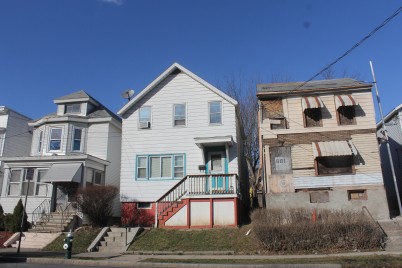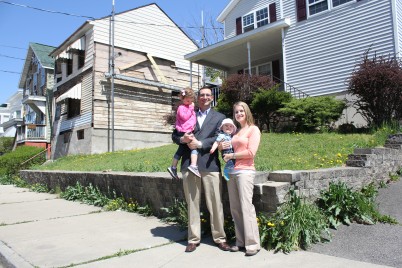By The Newsroom
East of Ridgefield Park is a street that encompasses much of what it means to live in the Pine Hills neighborhood. Long-time residents, young professionals and college students live side-by-side in a small community that resembles much of urban America.
From virtually any home on this quiet block, residents can look out their windows and see a single-family home with a well-manicured lawn and a fresh coat of paint, or an eyesore – a vacant, boarded up home in utter disrepair.
This is a snapshot of Park Avenue.

One building at 681 Park Ave. was registered as abandoned seven years ago in 2006, but, a fire 10 years earlier on March 17, 1996, is the last time the building was occupied, according to city records. The house has no staircase leading to the front door, and where its windows have been boarded up with plywood, a white spray-painted graffiti mark – a smiley face has been applied.
The owner of 681 Park, Patrick Landers, is an Albany firefighter and has lived in the neighborhood on and off for 20 years. It is a “very close-knit neighborhood,” he said, but has become more transient when college students temporarily move into the area.
Landers said he is renovating the building, and has gutted the inside and replaced the interior electric and water systems and is renovating the foundation as well. “But,” he acknowledged, “it’s still obviously not very pretty to look at.”
While the average value of a home in the neighborhood hovers around $170,000, according to Keith McDonald, commissioner of the city’s Department of Assessment and Taxation, Landers’ property is valued at $25,000.
After city officials did not respond to requests for information about the building, student reporters from The Pine Hills blog filed a request for records about 681 Park Ave. under the state Freedom of Information Law. The records show that the city inspected the building as recently as February 9 of this year and identified four code violations. That number is down from eight code violations reported in 2006, when the property was added to the vacant property registry.
Landers was recently instructed by the city to repair all missing siding and damaged exterior surfaces, paint all door and window coverings, register the vacant building with the city and remove all garbage and debris from the property.
Just to the east of 681 Park is a well-kept two-family rental property owned by Gregory Maida. Maida was initially a tenant in an apartment at 677 Park Ave. until he eventually bought the property and

became a landlord. He has filed complaints with the city about 681 Park and another building on the other side of his which was torn down in 2008.
None of Maida’s letters, addressed to Mayor Gerald Jennings, were supplied to The Pine Hills blog in response to its record request. In his letters years ago, Maida asked the mayor to have the building repaired or demolished.
Maida wrote: “The property at 681 Park Ave. has also not been occupied in quite some time. All of these buildings have broken windows and unlocked doors and are easily accessible for anyone to enter. These buildings are fire hazards, and they are in such bad shape that they are in imminent danger of falling down.”
The city has not yet supplied a copy of the original fire report from back on March 17, 1996, although City Clerk Nala Woodard said Thursday that the city’s Fire Department was rounding up those records. The city’s online filing system permits the public to request information from one department or agency at a time. Even though the original request specifically described the records needed, since the request was not submitted multiple times, the city chose not to fulfill the request.
After only some of the records were provided in response to the original request for information, a blog reporter contacted Robert Freeman, executive director of the state Committee on Open Government.
The public should not have to file multiple requests about the same topic, Freeman said. After contacting Freeman and filing another request for information, additional records were later supplied, including a city letter to Landers ordering him to correct the building violations by Jan, 22, 2013, or he would be subject to both criminal and civil penalties.
Landers’ building is one of approximately 10 abandoned buildings in the Pines Hills neighborhood – which accounts for only 1.1 percent of the total 846 citywide, according to Nicolette Callaway, an assistant at the Department of Buildings and Regulatory Compliance.
After writing letters to the city for two years, Maida was successful with his complaints about the former 673 Park Ave., a home and garage in such disrepair that both were finally demolished five years ago.
Maida, an associate broker at Miranda Real Estate, said he still struggles getting tenants interested in his property because of the neighboring 681. He also said he had a hard time getting insurance for his property because of the vacant house.
“I definitely believe that the state of 681 affects both property values and quality of life in the entire neighborhood,” said Maida. “Besides the physical appearance of the property and the lack of curb appeal for the neighboring properties, some people are concerned about the safety of the building because it may present a fire hazard, a potential for rodent infestation, or a place for kids to get into trouble. Though we have never had any serious issues, this building does pose potential dangers.”
He said he still bought his rental property, though, because “it was a good neighborhood.”
Quality of life issues like these are not uncommon in the city, according to Lt. Michael Tremblay, head of the police department’s Neighborhood Engagement Unit.
“A house becomes abandoned and one window goes un-repaired, then another becomes broken. Slowly but methodically, it moves throughout the neighborhood and becomes epidemic in especially low-income areas,” Tremblay said. “That, in turn, leads to more quality of life and other crimes.”
Issues involving alcohol, loud music, littering, and dog waste have been common for years, Tremblay said.
Graffiti decorates the Park Avenue side of the Ontario Street plaza which is home to the Playdium bowling alley.
Vandals have been an ongoing problem in the neighborhood for years and police have been trying to track the taggers, said Neil Luther, who owns the Playdium. The plaza has been repainted multiple times, but it is a challenge to find who is doing the damage.
Luther said the neighborhood has changed over the years, and he too pointed to college students as part of the problem: “There have been changes right along, more of a student presence; they have taken the area over.”
Most of the student who rent properties in the Pine Hills neighborhood rent from absentee landlords, said urban planning expert, Gene Bunnell, a professor at the University of Albany. Albany’s troublesome housing issues are the result of the combination of absentee ownership, a weak real estate market for older homes and college students’ attitude toward the quality of life for full-time residents.
“Students can be rough on properties, not all, but the fact is that students have a limited commitment to the neighborhood,” said Bunnell, who teaches in the department of geography and planning.
Take Ashley Smith, for instance, one of Maida’s short-term student tenants who moves out this month. “I think it’s safe for me,” she said of the neighborhood.
Students are indifferent about their apartment’s aesthetics and rarely ask that repairs are made because they only live there for a short period of time, Bunnell said. The houses eventually become run-down, yet landlords have little incentive to invest in their properties because students still pay the rents at the end of every month.
One way to help resolve the case of decaying neighborhoods, said UAlbany’s Bunnell, if for landlords to invest in two and multi-family properties and then live in them. This approach has worked successfully in Montreal, Canada, when Bunnell has studied development. When the “absentee” component of the equation is omitted, Bunnell said, owners who lives in their homes are motivated to maintain them. And, tenants are less likely to “trash” a property is the landlord lives there too.
Still, on the south side of Park, just west of the abandoned building, 702 Park Ave. was scooped up by a potential buyer in less than a month after it was put on the market back in March, according to Patsy Whitney, a real estate broker who listed the property. The sale has not yet been closed, according to the assessor’s office.
In her virtual online tour of the single-family brick home she listed, Whitney devoted most of her time describing the inside of the home, and panned over the street view and neighborhood at warp speed, while still describing the area in the shadow of Albany’s clay tennis courts as “desirable.”
One longtime Park Avenue resident who sees the boarded up and run-down 681 every morning, is Diane Schuetze. She has lived in her home for 18 years.
“I have been wondering why the city has not torn down the building,” Schuetze said. “It is not safe, and makes the neighborhood look bad.”
[This story was researched and reported by: Samuel Maxwell, Matt Henderson, Kaylee Pagano, Caroline Murray, Laura Sarsfield, Jackson Wang, Kaitlyn Jasnica, Kelly Pfeister, Lauren Klose, Joshua Natoli, Lauren Halligan, Hannah Vair, Seaneeba Thompson, Blaise Bryant]

